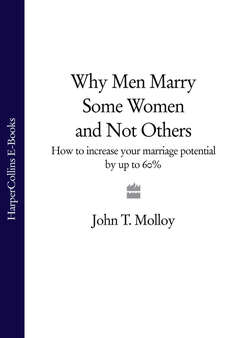Читать книгу Why Men Marry Some Women and Not Others: How to Increase Your Marriage Potential by up to 60% - John Molloy T. - Страница 18
Statistical Truths About the Marrying Kind
ОглавлениеMost men will not even consider marriage before they reach the age of commitment. For 80 percent of high school graduates, the minimum age of commitment is twenty-three, whereas for 80 percent of college graduates, it’s twenty-six.
The high-commitment period for most college-educated men is from ages twenty-eight to thirty-three.
For men who go to graduate school—doctors, lawyers, and the like—the high-commitment period runs from thirty to thirty-six.
After age thirty-seven or thirty-eight, the chance that a man will commit diminishes. After forty-three, it diminishes even more.
Most men think sowing their wild oats is a rite of passage and will not even contemplate marriage until they have been working and living as independent adults for several years.
Men are most likely to marry after they become uncomfortable with the singles scene.
Men have biological clocks. They want to be young enough to teach their sons to fish and play ball, and to do the male-bonding thing.
Men who look at marriage as a financial arrangement in which women have the most to gain are not likely to marry—nor are they good prospects. Run … fast.
Men whose parents divorced when they were young are often gun-shy about marrying.
Men often marry women whose backgrounds—religion, politics, values, socioeconomic status—match theirs.
Men who have their own places and have lived as independent, self-supporting adults are more likely to marry.
Men whose friends and siblings are married are more likely to marry.
If a man over the age of forty has been married before, he is more likely to marry than a forty-year-old man who has never been married.
If you wish to facilitate a trip to the altar, meet and date only the marrying kind!
